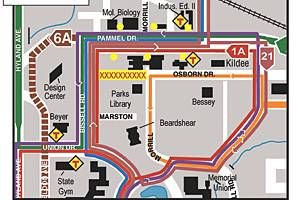CyRide proposes route changes, seeks community input
March 1, 2017
The Iowa State community discussed changes to CyRide that may affect students, faculty and staff who frequent the university’s bus routes.
The four-decade long service takes students and Ames residents all over campus and the city, making almost 7 million trips each year.
As the demand for CyRide services grew dramatically over the last decade and continues to do so, the organization recognizes the need for some updates.
Last July, CyRide, assisted by national transportation consultants NelsonNygaard, began a year-long study examining the most efficient way to run the service.
CyRide presented its findings and suggestions to the community at a public meeting Wednesday afternoon in the Memorial Union. Thomas Wittmann of Nelson/Nygaard presented two different scenarios regarding how CyRide routes and schedules may change.
The finalized version, which will be determined around the end of March, will feature a combination of the two based on community input.
CyRide hopes to begin implementation of the final restructuring in the fall of 2018.
The first scenario would include modest changes to current routes in an attempt to avoid overloading buses and to help keep them on schedule. It would only change about half of the CyRide routes, leaving much of the current structure intact with few changes.
The plan would add more frequent stops for 1 Red, 1A Cherry (formerly 1A Red), 3 Blue and 6 Brown. Wittman hopes to put the extra buses that usually follow these routes on a fixed schedule to increase the frequency of buses along popular routes during times of heavy traffic.
“Many of the routes in the morning times are scheduled to come every 20 minutes,” Wittman said. “We have a lot of buses back-to-back, and so rather than having multiple buses spaced every 20 minutes, we’d be looking in the morning times to take those extra buses and put them on the schedule on a regular basis.”
While this plan will increase frequency, it may reduce the riding capacity at each individual stop, because extra buses will be given their own scheduled stop. Because of this, students may have to wait 10 minutes or so during peak hours.
“There will still be extra buses,” Wittmann said. “But the emphasis on having two or three or eight buses back-to-back make sure everybody is accommodated on a certain trip would go away. And this is for both scenarios.”
Scenario one also looks to increase speed and reliability along 1A Cherry and 7 Purple. This plan would alter their routes along Union Drive into campus, turning buses around before Osborne Drive. For route 2 Green, this plan would adjust its schedule to serve Ames High School during school-time trips only.
Under scenario one, East Ames would be served by a reconstructed 4 Gray route, eliminating the 10 Pink Route. It would also change 4 Gray’s schedule, allowing its buses to run all day.
Finally, this scenario would change route 5 Yellow to run every 30 minutes all day and operate on Saturdays. It would also eliminate 22 Gold and consolidate it with 6 Brown, which would deviate to Lynn Avenue.
The second scenario would be far more transformative, making major changes to all but two routes. It looks at increasing the number of trips in some areas and decreasing it in others to balance the high demand for public transportation.
The plan would make major changes to routes on the northside of campus. It would create a new Gold Route that would run from the Towers to Schilletter Village every 10 minutes and consolidate the northern part of 3 Blue with 2 Green and 22 Gold.
This would mean that 2 Green would act as the main bus to North Grand Mall, rather than 3 Blue. However, this plan would also leave roughly 20 people along 24th Street without access to service. 2 Green would also limit trips to Ames High School to two morning and two evening trips.
Scenario two would also increase frequency on 1 Red, 3 Blue, 23 Orange and 22 Gold routes. It would also provide South Duff with evening service, weekday service, stops every 30 minutes all day and direct service into Iowa State.
This scenario would also establish a new route, 25 Peach, that would serve the College of Veterinary Medicine, Applied Sciences and the ISU Research Park. The route would feature a bus every hour.
For East Ames, this new plan has the potential to implement a flexible “Dial-a-Ride” system, rather than a fixed route service, called the Innovated Transit Service. Passengers would call or use an app to request transportation and meet a vehicle at a fixed location during a certain period of time. This feature would serve mainly the area near DMACC and the hotels on 16th Street east of Dayton Avenue.
For West Ames, this plan will implement a new 12 Lilac route, increase the frequency of stops along 1A Cherry and 7 Purple and change these routes to serve southern campus exclusively.
While both scenarios have their advantages, and their drawbacks, CyRide and Wittmann hope to combine both scenarios based on community input.
“Ultimately, we’re not looking at saying we’re going to pick scenario one or scenario two,” Wittmann said. “We’re looking at ‘what is it that you like about scenario one? What is it that you like about scenario two?’ And help us understand some of the things that you would like to see move forward in the ultimate preferred alternative,” Wittmann said.
CyRide is hosting an online survey on the proposed route changes until March 15. To leave input, visit www.surveymonkey.com/r/mycyride.
















